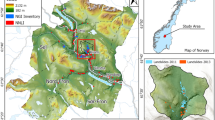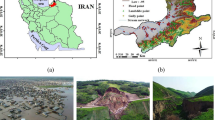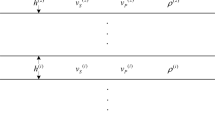Abstract
This paper investigates a novel hybrid model that employs Henry’s gas solubility optimization algorithm to search for adaptive weights of a deep neural network for a landslide susceptibility application. The model is trained using 13 features from a case study site in Viet Nam, including topographically derived data, satellite-derived indexes, physical and climatic information. The training and validating process terminated with the Root mean square error = 0.3898, Mean absolute error = 0.3115, Area under Receiving characteristic curves = 0.862, and Overall accuracy = 0.7831. The results show that the proposed model outperforms other methods, and it was used to map the susceptible level of the entire study area. Therefore, this model can be used as an alternative method for similar landslide studies and other natural hazard analyses, given input data availability.







Similar content being viewed by others
Data availability
The data are extractable from Vietnam institute of geosciences and mineral resources at http://www.canhbaotruotlo.vn/ and https://earthexplorer.usgs.gov/
References
Alimohammadlou Y, Najafi A, Gokceoglu C (2014) Estimation of rainfall-induced landslides using ANN and fuzzy clustering methods: a case study in Saeen Slope, Azerbaijan province Iran. CATENA 120:149–162
Ballabio C, Sterlacchini S (2012) Support vector machines for landslide susceptibility mapping: the Staffora River Basin case study, Italy. Math Geosci 44:47–70
Borga M, Anagnostou EN, Blöschl G, Creutin JD (2011) Flash flood forecasting, warning and risk management: the HYDRATE project. Environ Sci Policy 14:834–844
Bui QT, Van Pham M, Hang NTT, Nguyen QH, Linh NX, Hai PM, Tuan TA, Van Cu P (2018) Hybrid model to optimize object-based land cover classification by meta-heuristic algorithm: an example for supporting urban management in Ha Noi. Viet Nam. Int J Digit Earth 12(10):1118–1132
Bui Q-T, Nguyen Q-H, Nguyen XL, Pham VD, Nguyen HD, Pham VM (2020) Verification of novel integrations of swarm intelligence algorithms into deep learning neural network for flood susceptibility mapping. J Hydrol 581:124379
BUI Q-T (2019) Metaheuristic algorithms in optimizing neural network: a comparative study for forest fire susceptibility mapping in Dak Nong Vietnam. Geomat Nat Hazard Risk 10:136–150
Chen W (2016) GIS-based landslide susceptibility mapping using analytical hierarchy process (AHP) and certainty factor (CF) models for the Baozhong region of Baoji City. China. Environ Earth Sci 75:63
Chen W, Shahabi H, Zhang S, Khosravi K, Shirzadi A, Chapi K, Pham B, Zhang T, Zhang L, Chai H, Ma J, Chen Y, Wang X, Li R, Bin B (2018) Landslide susceptibility modeling based on GIS and novel bagging-based kernel logistic regression. Appl Sci 8:2540
Chou TY, Hoang TV, Fang YM, Nguyen QH, Lai TA, Pham VM, Vu VM, Bui QT (2020) Swarm-based optimizer for convolutional neural network: an application for flood susceptibility mapping. Transact GIS 25(2):1009–1026
Conforti M, Aucelli P, Robustelli G, Scarciglia F (2011) Geomorphology and GIS analysis for mapping gully erosion susceptibility in the Turbolo Stream catchment (Northern Calabria, Italy). Nat Hazard 56:881–898
Dahal RK, Hasegawa S, Nonomura A, Yamanaka M, Dhakal S, Paudyal P (2008) Predictive modelling of rainfall-induced landslide hazard in the Lesser Himalaya of Nepal based on weights-of-evidence. Geomorphology 102:496–510
Dash M, Liu H (1997) Feature selection for classification. Intell Data Anal 1:131–156
Destro E, Amponsah W, Nikolopoulos EI, Marchi L, Marra F, Zoccatelli D, Borga M (2018) Coupled prediction of flash flood response and debris flow occurrence: application on an alpine extreme flood event. J Hydrol 558:225–237
Dou J, TienBui D, Yunus AP, Jia K, Song X, Revhaug I, Huan X, Zhu Z (2015) Optimization of causative factors for landslide susceptibility evaluation using remote sensing and GIS data in parts of Niigata, Japan. PLoS One 10:e0133262
Dou J, Yunus AP, Tien Bui Merghadi Sahana Zhu Chen Khosravi Yang Pham DAMZCWKYBT (2019) Assessment of advanced random forest and decision tree algorithms for modeling rainfall-induced landslide susceptibility in the Izu-Oshima Volcanic Island, Japan. Sci Total Environ 662:332–346
Ermini L, Catani F, Casagli N (2005) Artificial neural networks applied to landslide susceptibility assessment. Geomorphology 66:327–343
Feizizadeh B, Blaschke T (2013) GIS-multicriteria decision analysis for landslide susceptibility mapping: comparing three methods for the Urmia lake basin. Iran Nat Hazard 65:2105–2128
Froude MJ, Petley D (2018) Global fatal landslide occurrence from 2004 to 2016. Nat Hazard 18:2161–2181
Galli M, Ardizzone F, Cardinali M, Guzzetti F, Reichenbach P (2008) Comparing landslide inventory maps. Geomorphology 94:268–289
Gökceoglu C, Aksoy H (1996) Landslide susceptibility mapping of the slopes in the residual soils of the Mengen region (Turkey) by deterministic stability analyses and image processing techniques. Eng Geol 44:147–161
Guha-Sapir D, Hoyois P, Below R, Vanderveken A (2016) Annual disaster statistical review 2015: The Numbers and Trends. CRED, Brussels
Guida D, Pelfini M, Santilli M (2008) Geomorphological and dendrochronological analyses of a complex landslide in the Southern Apennines. Geogr Ann Ser B 90:211–226
Hasekioğullar G, Ercanoglu M (2012) A new approach to use AHP in landslide susceptibility mapping: a case study at Yenice (Karabuk, NW Turkey). Nat Hazard 63:1157–1179
Hashim FA, Houssein EH, Mabrouk MS, Al-Atabany W, Mirjalili S (2019) Henry gas solubility optimization: a novel physics-based algorithm. Futur Gener Comput Syst 101:646–667
Hong H, Pourghasemi HR, Pourtaghi ZS (2016) Landslide susceptibility assessment in Lianhua County (China): a comparison between a random forest data mining technique and bivariate and multivariate statistical models. Geomorphology 259:105–118
Kadavi PR, Lee C-W, Lee S (2019) Landslide-susceptibility mapping in Gangwon-do, South Korea, using logistic regression and decision tree models. Environ Earth Sci 78:116
Khan H, Shafique M, Khan MA, Bacha MA, Shah SU, Calligaris C (2019) Landslide susceptibility assessment using frequency ratio, a case study of northern Pakistan. Egypt J Remote Sens Space Sci 22:11–24
Lee S, Ryu J-H, Won J-S, Park H-J (2004) Determination and application of the weights for landslide susceptibility mapping using an artificial neural network. Eng Geol 71:289–302
Lee S, Lee MJ, Jung HS, Lee S (2019) Landslide susceptibility mapping using Naïve Bayes and Bayesian network models in Umyeonsan. Korea. Geocarto Int 35(15):1665–1679
Myronidis D, Papageorgiou C, Theophanous S (2015) Landslide susceptibility mapping based on landslide history and analytic hierarchy process (AHP). Nat Hazard 81:245–263
Nguyen VV, Pham BT, Vu BT, Prakash I, Jha S, Shahabi H, Shirzadi A, Ba DN, Kumar R, Chatterjee JM (2019) Hybrid machine learning approaches for landslide susceptibility modeling. Forests 10:157
Nguyen HD, Pham VD, Nguyen QH, Pham VM, Manh V, Bui QT (2020a) An optimal search for neural network parameters by Salp swarm optimization algorithm: a landslide application. Remote Sens Lett 11(4):353–362
Nguyen H-D, Pham V-D, Nguyen Q-H, Pham V-M, Pham MH, Vu VM, Bui Q-T (2020b) An optimal search for neural network parameters using the Salp swarm optimization algorithm: a landslide application. Remote Sens Lett 11:353–362
Oh H-J, Pradhan B (2011) Application of a neuro-fuzzy model to landslide-susceptibility mapping for shallow landslides in a tropical hilly area. Comput Geosci 37:1264–1276
Othman AN, Naim WM, Noraini S (2012) GIS based multi-criteria decision making for landslide hazard zonation. Procedia Soc Behav Sci 35:595–602
Petley D (2012) Global patterns of loss of life from landslides. Geology 40:927–930
Pham VD, Nguyen Q, Nguyen H, Pham V, Vu VM, Bui Q (2020) Convolutional neural network—optimized moth flame algorithm for shallow landslide susceptible analysis. IEEE Access 8:32727–32736
Pourghasemi HR, Jirandeh AG, Pradhan B, Xu C, Gokceoglu C (2013a) Landslide susceptibility mapping using support vector machine and GIS at the Golestan Province Iran. J Earth Syst Sci 122:349–369
Pourghasemi HR, Pradhan B, Gokceoglu C, Mohammadi M, Moradi HR (2013b) Application of weights-of-evidence and certainty factor models and their comparison in landslide susceptibility mapping at Haraz watershed Iran. Arab J Geosci 6:2351–2365
Pradhan B, Sezer EA, Gokceoglu C, Buchroithner MF (2010) Landslide susceptibility mapping by neuro-fuzzy approach in a landslide-prone area (Cameron Highlands, Malaysia). IEEE Trans Geosci Remote Sens 48:4164–4177
Rahmati O, Zeinivand H, Besharat M (2016) Flood hazard zoning in Yasooj region, Iran, using GIS and multi-criteria decision analysis. Geomat Nat Haz Risk 7:1000–1017
Regmi AD, Devkota KC, Yoshida K, Pradhan B, Pourghasemi HR, Kumamoto T, Akgun A (2014) Application of frequency ratio, statistical index, and weights-of-evidence models and their comparison in landslide susceptibility mapping in Central Nepal Himalaya. Arab J Geosci 7:725–742
Roodposhti MS, Aryal J, Pradhan B (2019) A novel rule-based approach in mapping landslide susceptibility. Sensors 19:2274
Shahabi H, Khezri S, Ahmad BB, Hashim M (2014) Landslide susceptibility mapping at central Zab basin, Iran: a comparison between analytical hierarchy process, frequency ratio and logistic regression models. CATENA 115:55–70
Shirzadi A, Bui DT, Pham BT, Solaimani K, Chapi K, Kavian A, Shahabi H, Revhaug I (2017) Shallow landslide susceptibility assessment using a novel hybrid intelligence approach. Environ Earth Sci 76:60
Thai Pham B, Shirzadi A, Shahabi H, Omidvar E, Singh SK, Sahana M, Talebpour Asl D, BIN Ahmad B, Kim Quoc N, Lee S (2019) Landslide susceptibility assessment by novel hybrid machine learning algorithms. Sustainability (2071-1050):11
Trigila A, Iadanza C, Esposito C, Scarascia-Mugnozza G (2015) Comparison of logistic regression and random forests techniques for shallow landslide susceptibility assessment in Giampilieri (NE Sicily, Italy). Geomorphology 249:119–136
Tsangaratos P, Ilia I (2015) Landslide susceptibility mapping using a modified decision tree classifier in the Xanthi perfection Greece. Landslides 13(2):305–320
Wolpert DH, Macready WG (1997) No free lunch theorems for optimization. IEEE Trans Evol Comput 1:67–82
Yao X, Tham L, Dai F (2008) Landslide susceptibility mapping based on support vector machine: a case study on natural slopes of Hong Kong, China. Geomorphology 101:572–582
Funding
Authors declare no funding for this work.
Author information
Authors and Affiliations
Contributions
The work was conceptualized by QHN, TYC, TVH, HDN, QTB. Data was curated by QHN, HDN. The formal analysis was investigated by all authors. All authors wrote the manuscript.
Corresponding author
Ethics declarations
Conflict of interest
Authors declare no conflict of interest.
Additional information
Publisher's Note
Springer Nature remains neutral with regard to jurisdictional claims in published maps and institutional affiliations.
Rights and permissions
About this article
Cite this article
Nguyen, QH., Chou, TY., Yeh, ML. et al. Henry’s gas solubility optimization algorithm in formulating deep neural network for landslide susceptibility assessment in mountainous areas. Environ Earth Sci 80, 414 (2021). https://doi.org/10.1007/s12665-021-09711-6
Received:
Accepted:
Published:
DOI: https://doi.org/10.1007/s12665-021-09711-6




